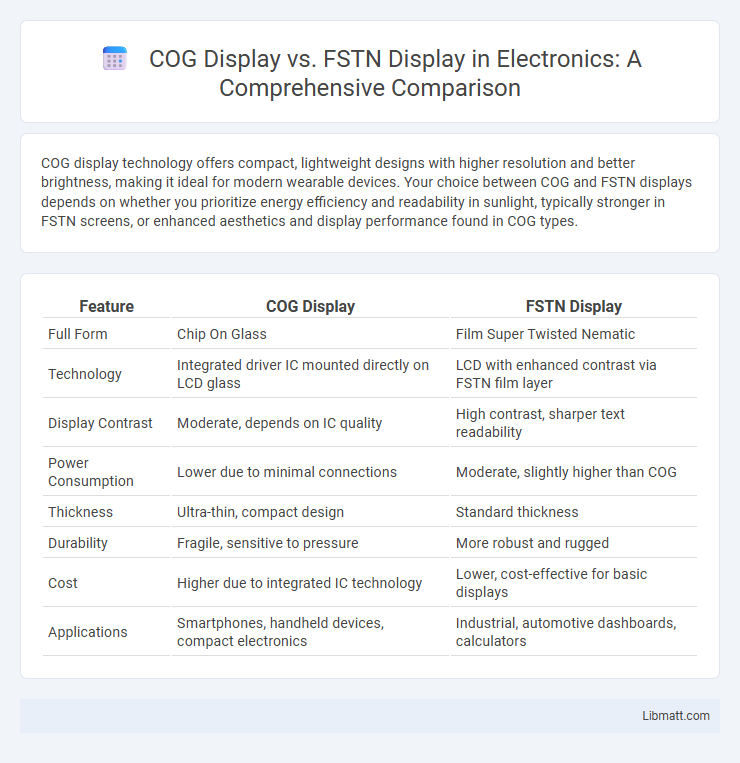COG display technology offers compact, lightweight designs with higher resolution and better brightness, making it ideal for modern wearable devices. Your choice between COG and FSTN displays depends on whether you prioritize energy efficiency and readability in sunlight, typically stronger in FSTN screens, or enhanced aesthetics and display performance found in COG types.
Table of Comparison
| Feature | COG Display | FSTN Display |
|---|---|---|
| Full Form | Chip On Glass | Film Super Twisted Nematic |
| Technology | Integrated driver IC mounted directly on LCD glass | LCD with enhanced contrast via FSTN film layer |
| Display Contrast | Moderate, depends on IC quality | High contrast, sharper text readability |
| Power Consumption | Lower due to minimal connections | Moderate, slightly higher than COG |
| Thickness | Ultra-thin, compact design | Standard thickness |
| Durability | Fragile, sensitive to pressure | More robust and rugged |
| Cost | Higher due to integrated IC technology | Lower, cost-effective for basic displays |
| Applications | Smartphones, handheld devices, compact electronics | Industrial, automotive dashboards, calculators |
Introduction to COG and FSTN Displays
COG (Chip on Glass) displays integrate the driver IC directly onto the display glass, resulting in a compact, lightweight design ideal for slim devices. FSTN (Film Super Twisted Nematic) displays offer high contrast and wide viewing angles by utilizing a specialized polarizing film, enhancing readability in various lighting conditions. Both technologies cater to different application needs: COG prioritizes miniaturization, while FSTN emphasizes improved visual performance.
What is a COG Display?
A COG Display (Chip-On-Glass) integrates the driver IC directly onto the glass substrate of the LCD panel, minimizing space and enhancing compactness in devices. This design improves signal transmission speed and reduces power consumption compared to traditional FSTN (Film Super Twisted Nematic) displays, which use a separate driver board. Your choice between COG and FSTN impacts device thickness, clarity, and energy efficiency, with COG displays often preferred for sleek, modern electronics.
What is an FSTN Display?
An FSTN display, or Film Compensated Super Twisted Nematic display, is a type of LCD technology that enhances readability under various lighting conditions by improving contrast and viewing angles. It uses a compensating film layer to correct optical properties, resulting in sharper and clearer text compared to traditional COG (Chip on Glass) displays, which integrate the driver chip directly onto the glass substrate primarily for compactness and cost efficiency. FSTN displays are commonly employed in devices requiring high visibility and durability, such as industrial instruments, outdoor screens, and handheld gadgets.
Key Differences Between COG and FSTN Displays
COG (Chip on Glass) displays integrate the driver chip directly onto the glass substrate, resulting in a thinner, more compact design with reduced signal interference. FSTN (Film Super-Twisted Nematic) displays offer enhanced contrast and wider viewing angles through the use of a film layer that improves liquid crystal alignment. Your choice between COG and FSTN depends on whether you prioritize sleek form factor and cost-efficiency (COG) or superior visual performance and readability (FSTN).
Advantages of COG Display Technology
COG (Chip-on-Glass) display technology offers superior durability and a thinner profile compared to FSTN (Film Super Twisted Nematic) displays, making it ideal for compact electronic devices. COG displays provide higher resolution and better integration with the circuit, enhancing image clarity and reducing manufacturing complexity. You benefit from improved reliability and lower power consumption in applications requiring efficient, high-quality display solutions.
Advantages of FSTN Display Technology
FSTN Display technology offers superior contrast and clarity compared to COG Display, ensuring sharper visuals and easier readability in various lighting conditions. Its enhanced liquid crystal alignment reduces ghosting effects, providing a more stable and vibrant display performance. Choosing FSTN Display can improve your device's user experience by delivering crisp images and efficient power consumption.
Applications of COG vs FSTN Displays
COG displays are widely used in compact electronic devices such as smartwatches, fitness trackers, and handheld instruments due to their thin profile and excellent electrical performance. FSTN displays excel in applications requiring high contrast and wide viewing angles, such as industrial control panels, medical devices, and outdoor instrumentation. The choice between COG and FSTN displays depends on factors like device size, power consumption, and visibility under various lighting conditions.
Cost Comparison: COG vs FSTN Displays
COG (Chip-on-Glass) displays typically offer a lower cost advantage over FSTN (Film Super Twisted Nematic) displays due to their compact integration, reducing manufacturing complexity and material usage. FSTN displays, known for higher contrast and better readability in various lighting conditions, often incur greater production expenses because of additional layers and processing steps. Your choice between COG and FSTN should balance cost efficiency with performance requirements depending on the application.
Performance and Reliability: COG vs FSTN
COG (Chip on Glass) displays offer superior performance through higher resolution and faster response rates compared to FSTN (Film Super Twisted Nematic) displays, which are typically slower and have lower contrast ratios. In terms of reliability, COG displays provide enhanced durability due to fewer components and a more compact design, reducing potential failure points versus the multi-layered structure of FSTN panels. Your choice between COG and FSTN will depend on whether performance speed or cost-effective reliability is your priority in application.
Choosing the Right Display for Your Project
COG (Chip on Glass) displays offer a compact design ideal for projects requiring slim profiles and high reliability in harsh environments, making them perfect for wearable devices and industrial controls. FSTN (Film Super Twisted Nematic) displays provide higher contrast and better viewing angles, suitable for outdoor applications like handheld instruments and medical devices. Selecting the right display depends on prioritizing factors like size constraints, contrast needs, ambient light conditions, and overall durability for your specific project requirements.
COG Display vs FSTN Display Infographic

 libmatt.com
libmatt.com